Quantifying the Impact of Changes in Sinuosity on River Ecosystems
Abstract
1. Introduction
2. Materials and Methods
2.1. Study Area and Indicators
2.2. Hydraulic Model and WUA
2.3. Data Processing
2.4. Determination of the Suitability Curve
2.5. Model Building and Validation
2.6. Depth and Velocity Diversity Index
3. Results
3.1. Analysis of Water Depth and Flow Velocity Diversity at Each Sinuosity
3.2. Sinuosity and Ecological Flow
4. Discussion
4.1. Quantification of River Depth and Velocity Diversity
4.2. Habitat Modeling Methodology and Ecological Flows
4.3. Relationships between Changes in Sinuosity, River Ecology, and Socioeconomics
5. Conclusions
Author Contributions
Funding
Data Availability Statement
Acknowledgments
Conflicts of Interest
References
- Giller, P.S. River restoration: Seeking ecological standards. Editor’s introduction. J. Appl. Ecol. 2005, 42, 201–207. [Google Scholar] [CrossRef]
- Walteros, J.M.; Ramírez, A. Urban streams in Latin America: Current conditions and research needs. Rev. Biol. Trop. 2020, 68, 13–28. [Google Scholar] [CrossRef]
- Jähnig, S.; Hering, D.; Sommerhäuser, M. Fließgewässer-Renaturierung Heute und Morgen: EG-Wasserrahmenrichtlinie, Maßnahmen und Effizienzkontrolle; mit 55 Tabellen; Schweizerbart: Stuttgart, Germany, 2011. [Google Scholar]
- Lytle, D.A.; Poff, N. Adaptation to natural flow regimes. Trends Ecol. Evol. 2004, 19, 94–100. [Google Scholar] [CrossRef] [PubMed]
- Winkley, B.R. Man-Made Cutoffs on the Lower Mississippi River, Conception, Construction and River Response; Army Engineer District: Vicksburg, MS, USA, 1977. [Google Scholar]
- Arnaud, F.; Schmitt, L.; Johnstone, K.; Rollet, A.-J.; Piégay, H. Engineering impacts on the Upper Rhine channel and floodplain over two centuries. Geomorphology 2019, 330, 13–27. [Google Scholar] [CrossRef]
- Tao, G. Development and Prospects of Canalization Engineering in China. Adv. Sci. Technol. Water Resour. 1995, 4, 4–8+35. (In Chinese) [Google Scholar]
- Kadoya, M. A review of the study on runoff changes due to urbanization. Proc. JSCE 1985, 363. [Google Scholar] [CrossRef]
- Dong, Z.; Sun, D.; Zhao, J.; Jing, Z. River Restoration; China Water Conservancy and Hydropower Publishing: Beijing, China, 2013. (In Chinese) [Google Scholar]
- Dutta, V.; Sharma, U.; Iqbal, K.; Adeeba; Kumar, R.; Pathak, A.K. Impact of river channelization and riverfront development on fluvial habitat: Evidence from Gomti River, a tributary of Ganges, India. Environ. Sustain. 2018, 1, 167–184. [Google Scholar]
- Larsen, P. Restoration of River Corridors: German Experiences. In The Rivers Handbook: Hydrological and Ecological Principles; Wiley: Hoboken, NJ, USA, 1994; pp. 419–438. [Google Scholar]
- Li, P.; Li, D.; Sun, X.; Chu, Z.; Xia, T.; Zheng, B. Application of Ecological Restoration Technologies for the Improvement of Biodiversity and Ecosystem in the River. Water 2022, 14, 1402. [Google Scholar] [CrossRef]
- Tijdeman, E.; Hannaford, J.; Stahl, K. Human influences on streamflow drought characteristics in England and Wales. Hydrol. Earth Syst. Sci. 2018, 22, 1051–1064. [Google Scholar] [CrossRef]
- WarWarner, J.F.; van Buuren, A.; Edelenbos, J. Making Space for the River: Governance Experiences with Multifunctional River Flood Management in the US and Europe; IWA Publishing: London, UK, 2012. [Google Scholar]
- Wineland, S.M.; Bașağaoğlu, H.; Fleming, J.; Laura, G.-D.; Kellogg, W.; Koch, J.; Lane, B.A.; Mirchi, A.; Nava, L.F.; Neeson, Y.M.; et al. The environmental flows implementation challenge: Insights and recommendations across water-limited systems. Wiley Interdiscip. Rev. Water 2022, 9, e1565. [Google Scholar] [CrossRef]
- Xu, Z.; Wu, W.; Yu, S. Ecological baseflow: Progress and challenge. J. Hydroelectr. Eng. 2016, 35, 1–11. (In Chinese) [Google Scholar]
- Palmer, M.A.; Bernhardt, E.S. Hydroecology and river restoration: Ripe for research and synthesis. Water Resour. Res. 2006, 42, W03S07. [Google Scholar]
- Acreman, M.; Arthington, A.H.; Colloff, M.J.; Couch, C.; Crossman, N.D.; Dyer, F.J.; Overton, I.; Pollino, C.A.; Stewardson, M.J.; Young, W. Environmental flows for natural, hybrid, and novel riverine ecosystems in a changing world. Front. Ecol. Environ. 2014, 12, 466–473. [Google Scholar] [CrossRef] [PubMed]
- Ying, C.; Zhang, Q.; Chen, X.A.; Qiang, T. Advances in the theories and calculation methods of ecological water requirement. J. Lake Sci. 2010, 4, 465–480. (In Chinese) [Google Scholar]
- Brookes, A. River channel change. In The Rivers Handbook: Hydrological and Ecological Principles; Wiley-Blackwell: Hoboken, NJ, USA, 1994; Volume 2, pp. 55–75. [Google Scholar]
- Wang, Y.; Xia, J.; Cai, W.; Liu, Z.; Li, J.; Yin, J.; Zu, J.; Dou, C. Response of Fish Habitat Quality to Weir Distribution Change in Mountainous River Based on the Two-Dimensional Habitat Suitability Model. Sustainability 2023, 15, 8698. [Google Scholar] [CrossRef]
- Chunguang, Z.; Yahui, Z.; Yingchun, X.; Ruilu, G.; Qing, Z.; Yun, F.; Enyuan, F. Fish species diversity and conservation in Beijing and adjacent areas. Biodivers. Sci. 2011, 19, 597–604. [Google Scholar] [CrossRef]
- McManamay, R.A.; Brewer, S.K.; Jager, H.I.; Troia, M.J. Organizing Environmental Flow Frameworks to Meet Hydropower Mitigation Needs. Environ. Manag. 2016, 58, 365–385. [Google Scholar] [CrossRef]
- Steffler, P.; Blackburn, J. Two-Dimensional Depth Averaged Model of River Hydrodynamics and Fish Habitat. In River2D User’s Manual; University of Alberta: Edmonton, AB, Canada, 2002. [Google Scholar]
- Naderi, M.H.; Zakerinia, M.; Salarijazi, M. Improvement of habitat simulation method using River2D hydrodynamic model to determine ecological regime of river. Proc. R. Soc. Edinb. 2019, 72, 263–277. [Google Scholar]
- Bum, R.K.; Chun, P.S.; Hoon, J.Y.; Ok, P.M. Study on ecological instream flow estimation using River2D model in the Seomjin River. J. Korean Soc. Water Environ. 2011, 822–829. [Google Scholar]
- Leopold, L.B.; Wolman, M.G. River Channel Patterns: Braided, Meandering, and Straight; US Government Printing Office: Washinton, DC, USA, 1957.
- Yi, Y.; Wang, Z.; Yang, Z. Two-dimensional habitat modeling of Chinese sturgeon spawning sites. Ecol. Model. 2010, 221, 864–875. [Google Scholar] [CrossRef]
- Yang, Z.; Yu, S.; Chen, H.; She, D. Model for defining environmental flow thresholds of spring flood period using abrupt habitat change analysis. Adv. Water Sci. 2010, 21, 567–574. (In Chinese) [Google Scholar]
- Williams, C.B. Area and number of species. Nature 1943, 152, 264–267. [Google Scholar] [CrossRef]
- Fatch, P.; Masangano, C.; Hilger, T.; Jordan, I.; Mambo, I.; Kamoto, J.F.M.; Kalimbira, A.; Nuppenau, E.-A. Holistic agricultural diversity index as a measure of agricultural diversity: A cross-sectional study of smallholder farmers in Lilongwe district of Malawi. Agric. Syst. 2020, 187, 102991. [Google Scholar] [CrossRef]
- Li, C.; Gan, Y.; Chao, Z.; Huan, H.; Fang, J.; Wang, L.; Yan, W.; Jian, L. “Microplastic communities” in different environments: Differences, links, and role of diversity index in source analysis. Water Res. 2020, 188, 116574. [Google Scholar] [CrossRef] [PubMed]
- Zhang, A.; Dong, Z.; Zhao, J.; Sun, D. Progress of analysis and research on landscape pattern of river basin. Water Resour. Hydropower Eng. 2012, 7, 5. (In Chinese) [Google Scholar]
- Yu, G.A.; Wang, Z.Y.; Zhang, K.; Wang, F.X. Effect of artificial step-pools on improving aquatic habitats and stream ecological in incised river channel. J. Hydraul. Eng. 2008, 2, 162–167. (In Chinese) [Google Scholar]
- Stähly, S.; Gostner, W.; Franca, M.J.; Robinson, C.T.; Schleiss, A.J. Sampling sufficiency for determining hydraulic habitat diversity. J. Ecohydraulics 2018, 3, 130–144. [Google Scholar] [CrossRef]
- Bockelmann, B.N.; Fenrich, E.K.; Lin, B.; Falconer, R.A. Development of an ecohydraulics model for stream and river restoration. Ecol. Eng. 2004, 22, 227–235. [Google Scholar] [CrossRef]
- Roni, P.; Hall, J.E.; Drenner, S.M.; Arterburn, D. Monitoring the effectiveness of floodplain habitat restoration: A review of methods and recommendations for future monitoring. WIREs Water 2019, 6, e1355. [Google Scholar] [CrossRef]
- Xing, Y.; Lv, B.; Ma, D.; Zhang, H.; Yu, G. Hydrodynamic modeling to evaluate the influence of inland navigation channel training works on fish habitats in the Upper Yellow River. Ecol. Eng. 2021, 169, 106289. [Google Scholar]
- Maddock, I. The importance of physical habitat assessment for evaluating river health. Freshw. Biol. 1999, 41, 373–391. [Google Scholar] [CrossRef]
- Poff, N.L.; Zimmerman, J.K.H. Ecological responses to altered flow regimes: A literature review to inform the science and management of environmental flows. Freshw. Biol. 2010, 55, 194–205. [Google Scholar] [CrossRef]
- Alsterberg, C.; Roger, F.; Sundbäck, K.; Juhanson, J.; Hulth, S.; Hallin, S.; Gamfeldt, L. Habitat diversity and ecosystem multifunctionality—The importance of direct and indirect effects. Sci. Adv. 2017, 3, e1601475. [Google Scholar]
- Palmer, M.A.; Menninger, H.L.; Bernhardt, E. River restoration, habitat heterogeneity and biodiversity: A failure of theory or practice? Freshw. Biol. 2010, 55, 205–222. [Google Scholar] [CrossRef]
- Geist, J.; Hawkins, S.J. Habitat recovery and restoration in aquatic ecosystems: Current progress and future challenges. Aquat. Conserv. Mar. Freshw. Ecosyst. 2016, 26, 942–962. [Google Scholar] [CrossRef]
- Hohensinner, S.; Hauer, C.; Muhar, S. River morphology, channelization, and habitat restoration. In Riverine Ecosystem Management: Science for Governing towards a Sustainable Future; Springer: Cham, Switzerland, 2018; pp. 41–65. [Google Scholar]
- Gregory, K. The human role in changing river channels. Geomorphology 2006, 79, 172–191. [Google Scholar]
- Wanjie, Z.; Linjuan, X. Review on Artificial Bending Cutoff and Regulation of Distorted River Bends. In Proceedings of the 2018 3rd International Conference on Smart City and Systems Engineering (ICSCSE), Xiamen, China, 29–30 December 2018; pp. 905–907. [Google Scholar]
- Murniningsih, S. Analysis of the relation between meander river transformation and soil classification in urban area. IOP Conf. Ser. Earth Environ. Sci. 2020, 612, 012073. [Google Scholar]
- Graf, W.; Leitner, P.; Hanetseder, I.; Ittner, L.D.; Dossi, F.; Hauer, C. Ecological degradation of a meandering river by local channelization effects: A case study in an Austrian lowland river. Hydrobiologia 2016, 772, 145–160. [Google Scholar] [CrossRef]
- Saha, P.; Islam, M.; Oyshi, J.T.; Khanum, R.; Nishat, A. A sustainability analysis on the trends and frequency of the channel flow of a carp breeding river against human interventions and governing public–private partnership (PPP) as adaptation. SN Appl. Sci. 2020, 2, 969. [Google Scholar] [CrossRef]
- Gray, D.P.; Harding, J.S. Braided River Ecology: A Literature Review of Physical Habitats and Aquatic Invertebrate Communities; Science & Technical Pub., Department of Conservation: Setúbal, Portugal, 2007. [Google Scholar]
- Blettler, M.C.M.; Amsler, M.L.; Eberle, E.G.; Szupiany, R.; Latosinski, F.G.; Abrial, E.; Oberholster, P.J.; Espinola, L.A.; Paira, A.; Poza, A.; et al. Linking hydro-morphology with invertebrate ecology in diverse morphological units of a large river-floodplain system. Water Resour. Res. 2016, 52, 9495–9510. [Google Scholar] [CrossRef]
- Garcia, X.-F.; Schnauder, I.; Pusch, M.T. Complex hydromorphology of meanders can support benthic invertebrate diversity in rivers. Hydrobiologia 2011, 685, 49–68. [Google Scholar] [CrossRef]
- Lorenz, A.W.; Jähnig, S.C.; Hering, D. Re-meandering German lowland streams: Qualitative and quantitative effects of restoration measures on hydromorphology and macroinvertebrates. Environ. Manag. 2009, 44, 745–754. [Google Scholar] [CrossRef] [PubMed]
- Ran, Y.; Liu, Y.; Wu, S.; Li, W.; Zhu, K.; Ji, Y.; Mir, Y.; Ma, M.; Huang, P. A higher river sinuosity increased riparian soil structural stability on the downstream of a dammed river. Sci. Total. Environ. 2021, 802, 149886. [Google Scholar] [CrossRef] [PubMed]
- Nagayama, S.; Nakamura, F. The significance of meandering channel to habitat diversity and fish assemblage: A case study in the Shibetsu River, northern Japan. Limnology 2018, 19, 7–20. [Google Scholar] [CrossRef]
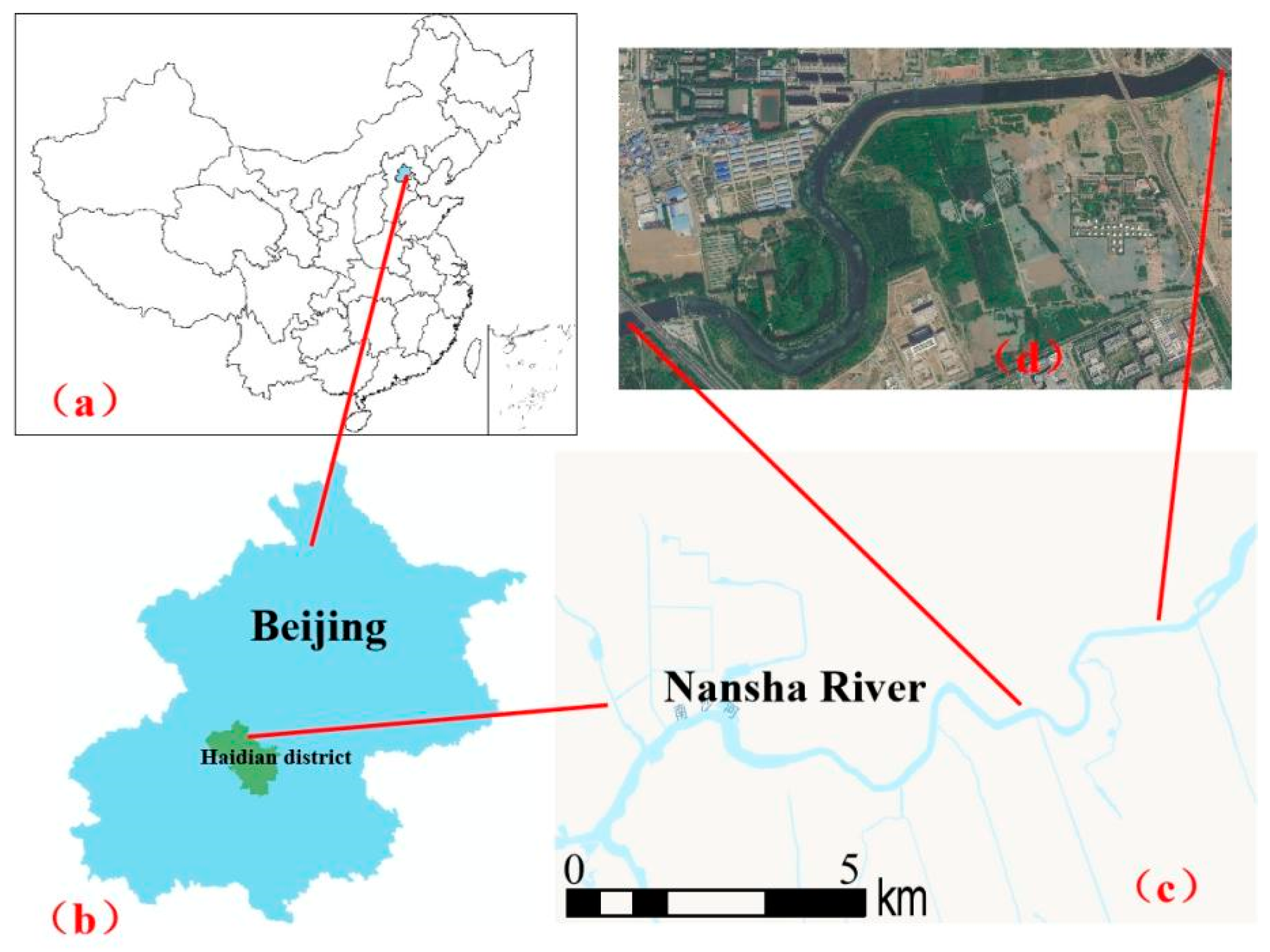
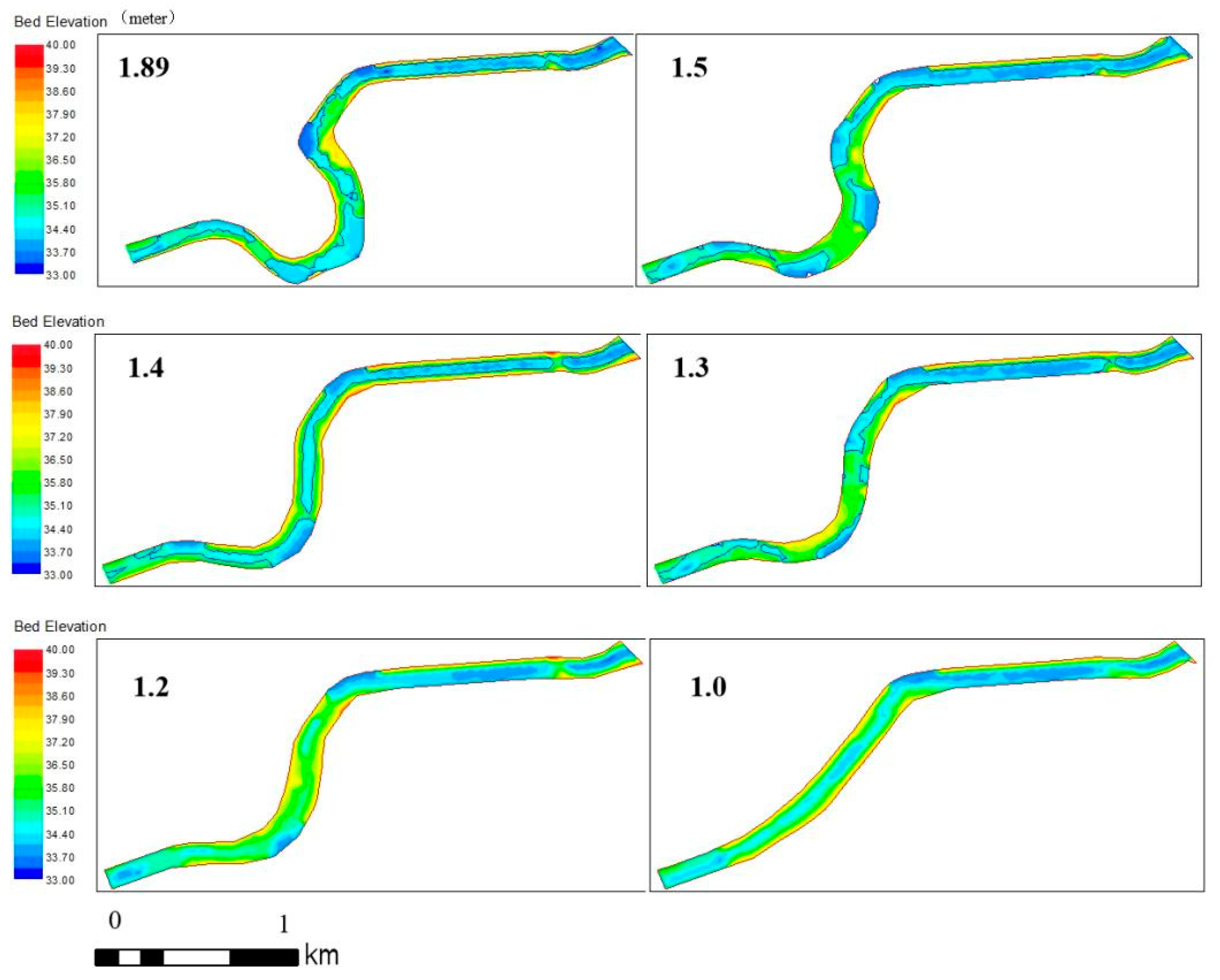

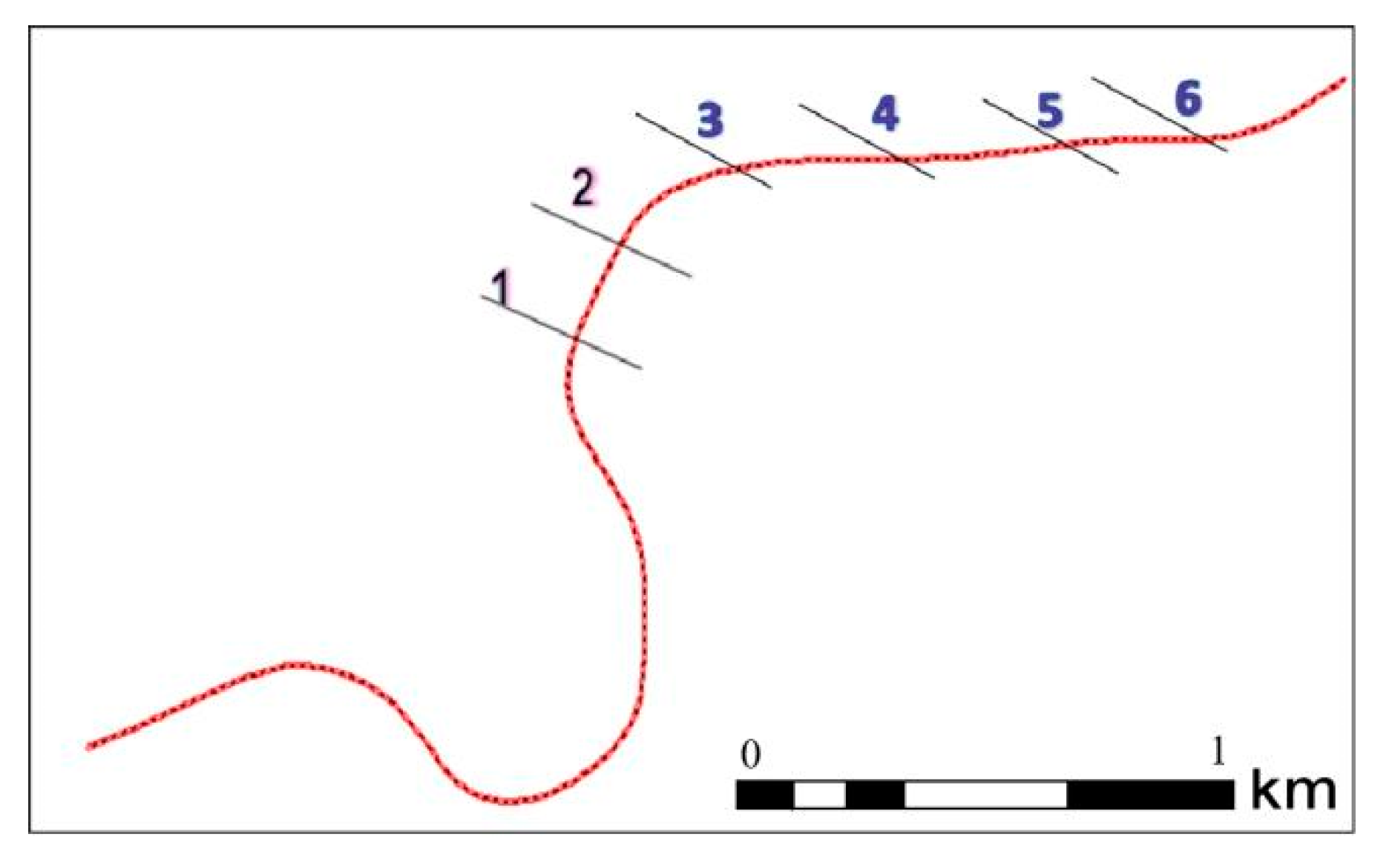
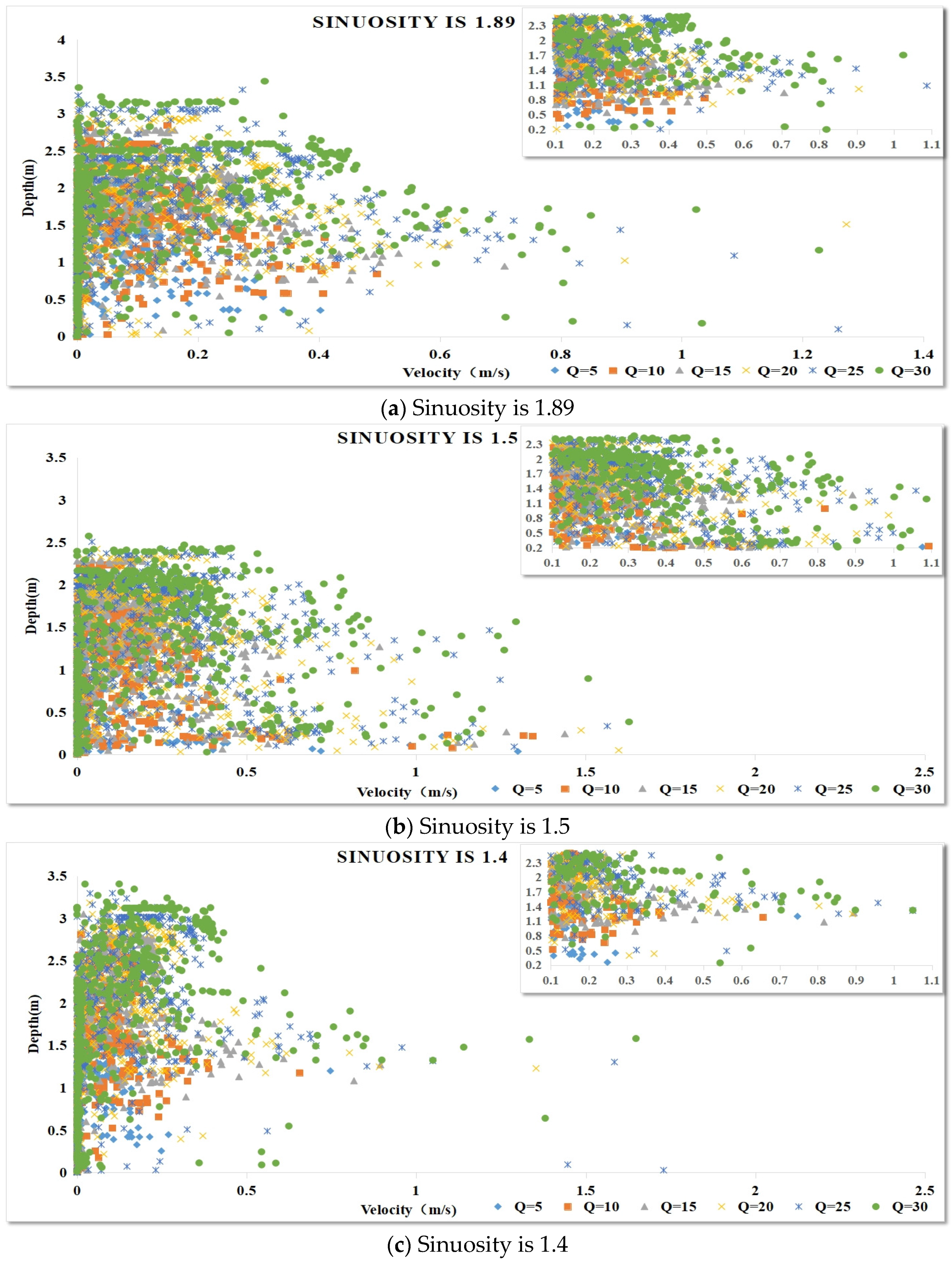
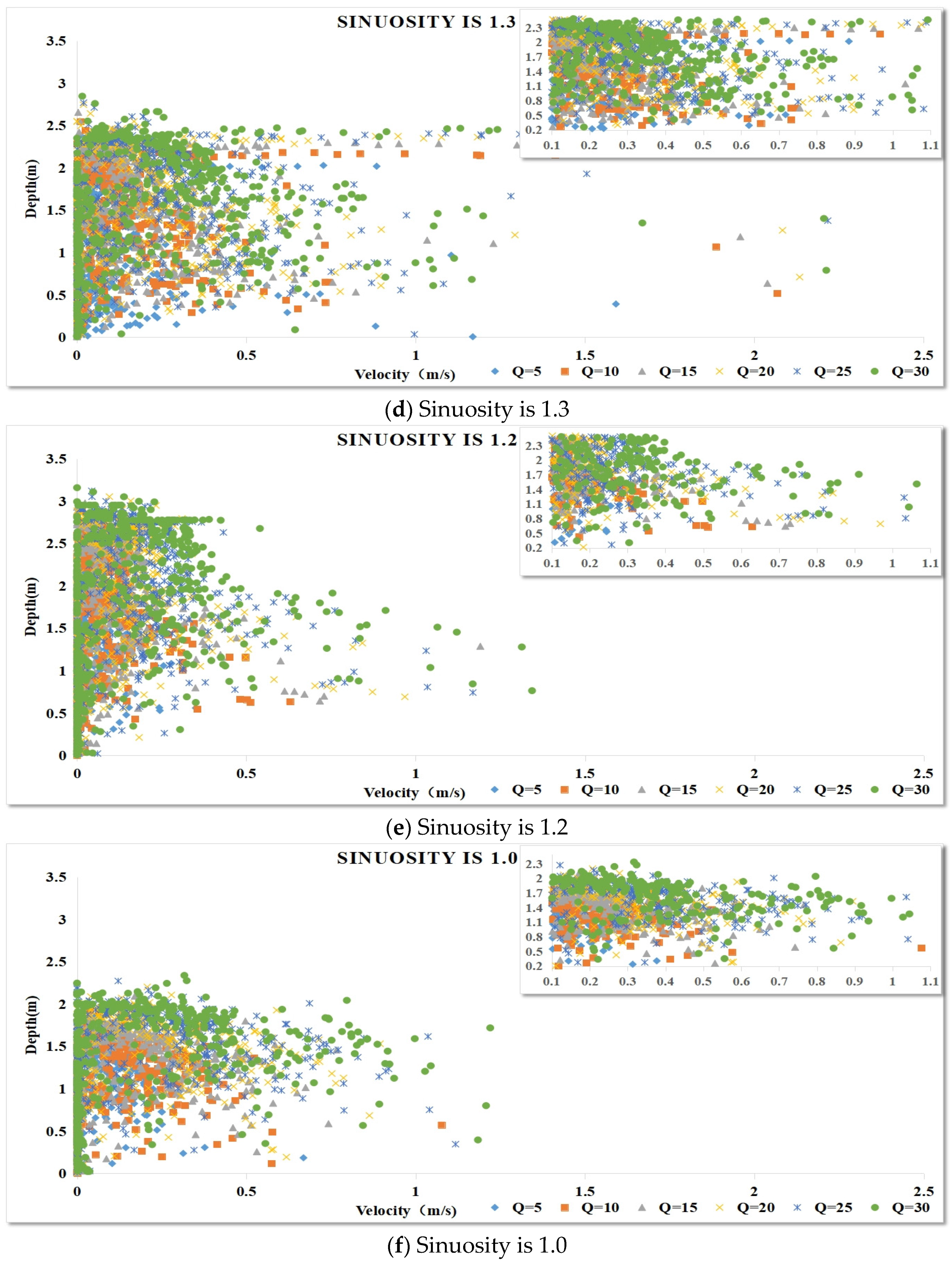
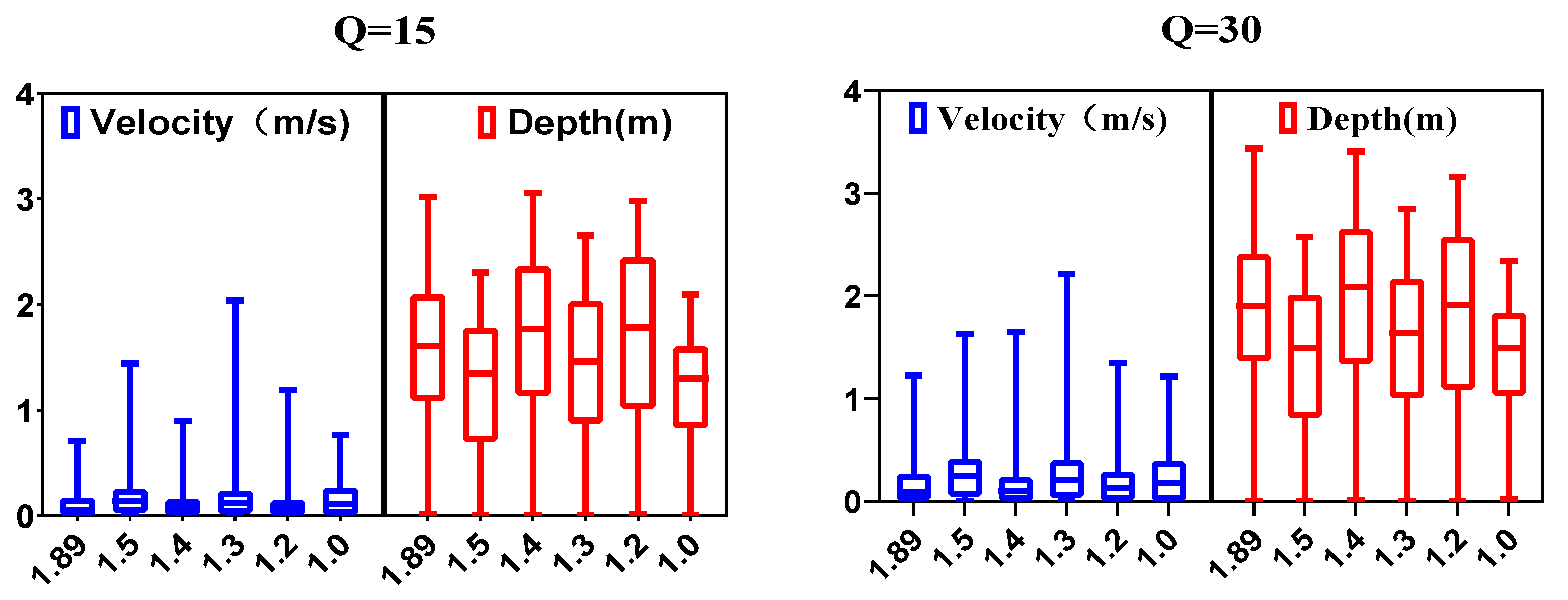
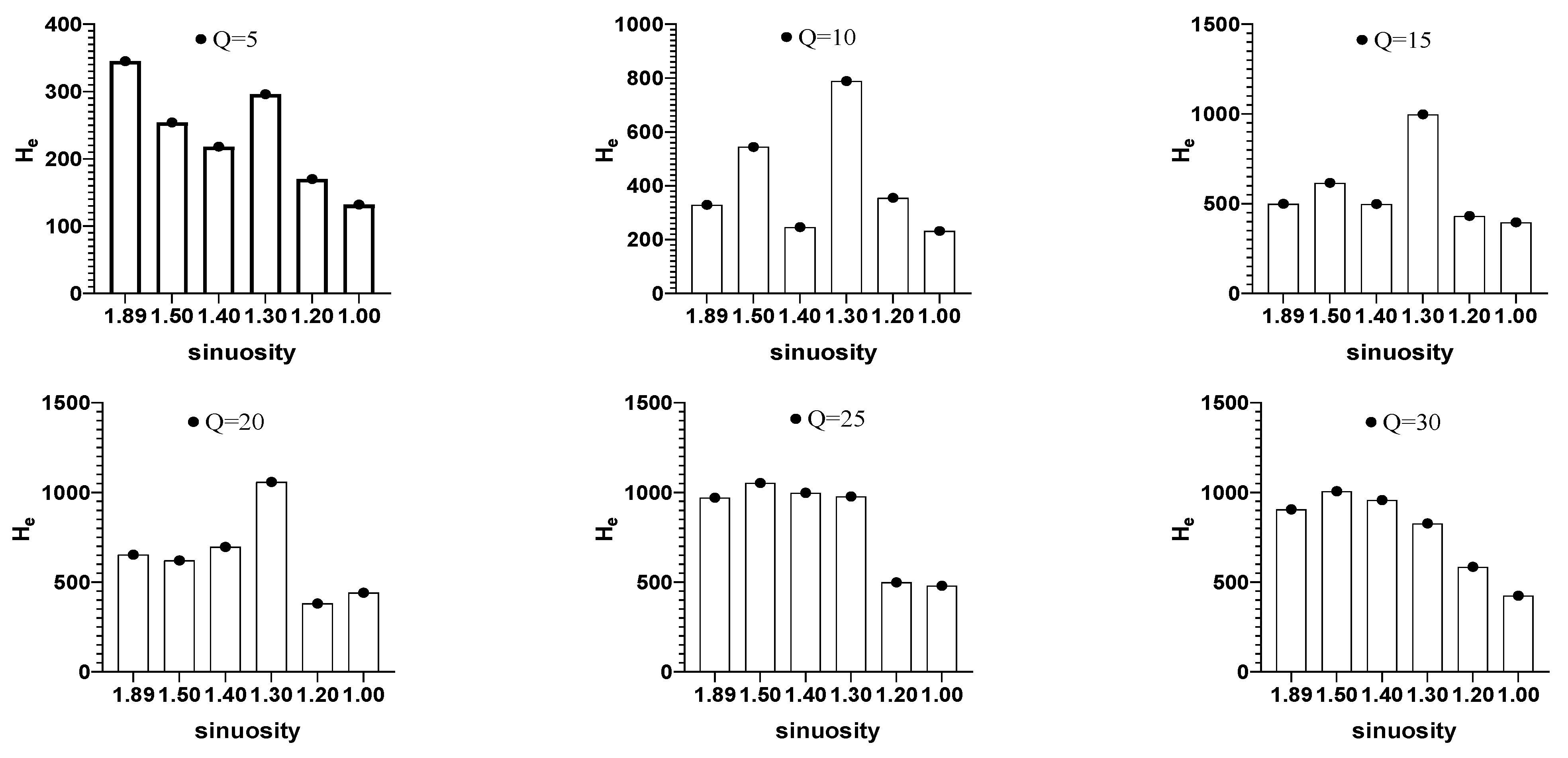

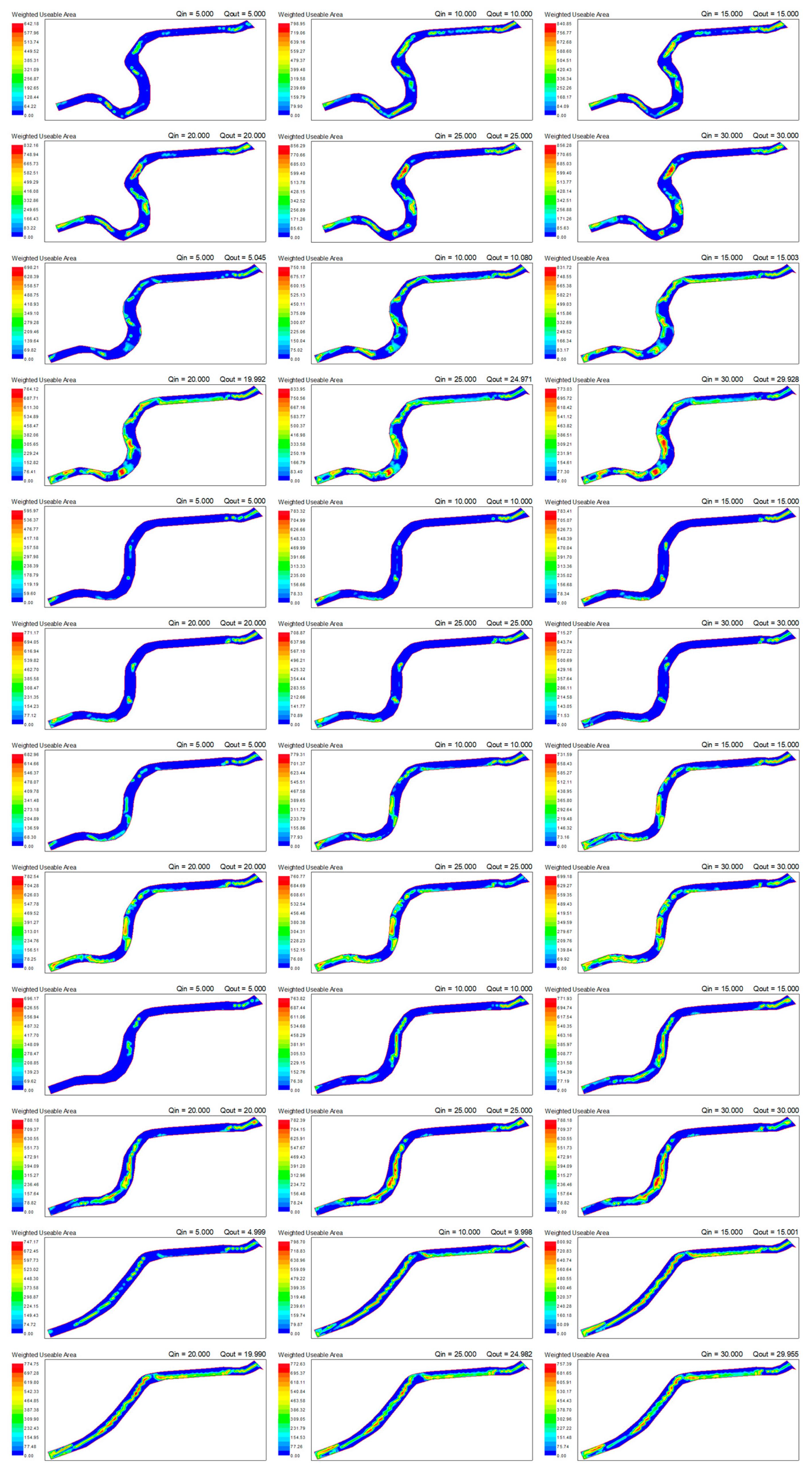

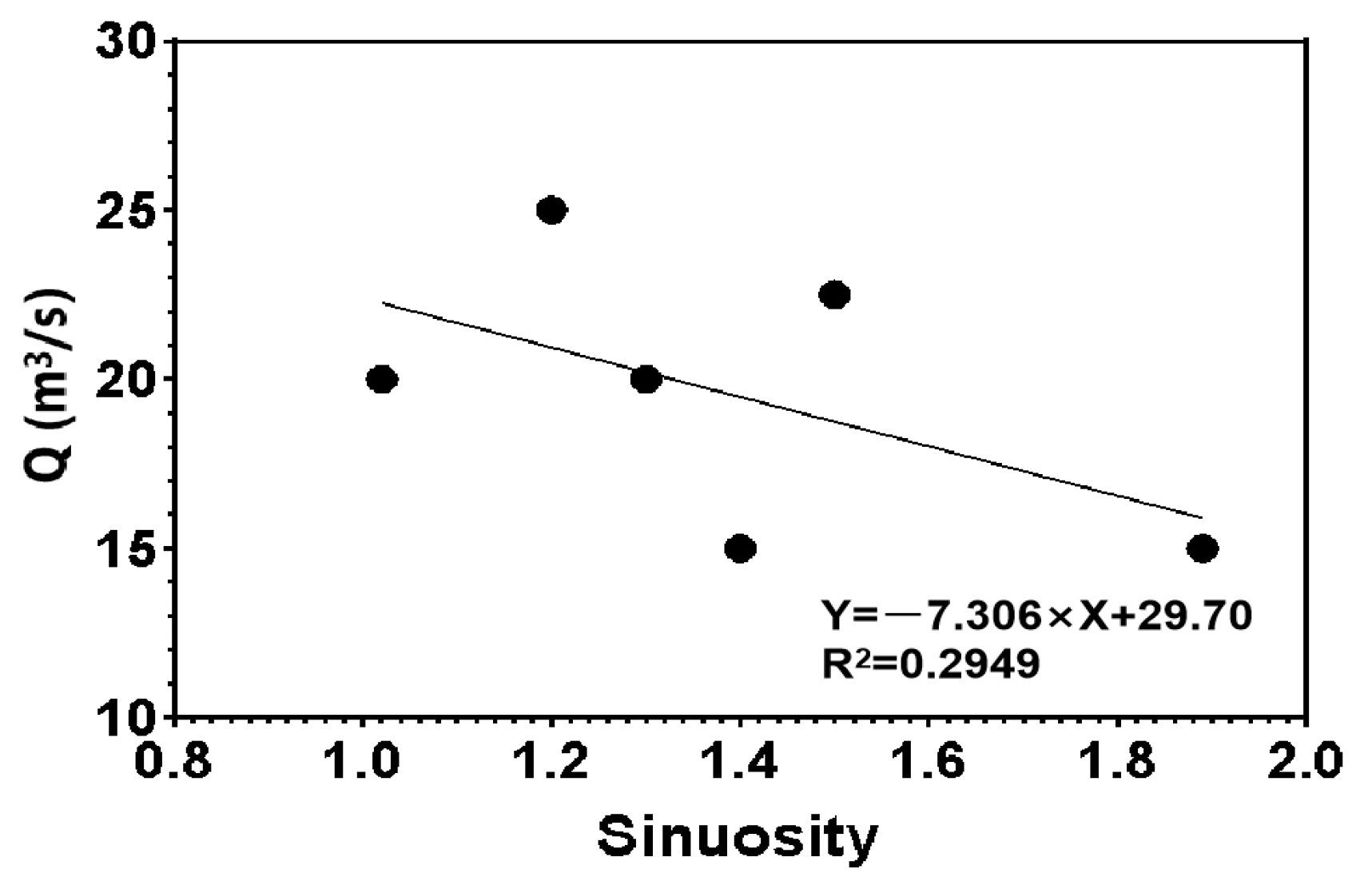
| Section Name | 1 | 2 | 3 | 4 | 5 | 6 |
|---|---|---|---|---|---|---|
| Simulated water level (m) | 38.55 | 38.43 | 38.20 | 38.08 | 37.96 | 37.92 |
| Design water level (approved dredging project) (m) | 38.45 | 38.40 | 38.40 | 38.39 | 38.36 | 38.28 |
| Relative error (%) | 0.26 | 0.08 | 0.52 | 0.80 | 1.05 | 0.98 |
| S | 1.89 | 1.5 | 1.4 | 1.3 | 1.2 | 1.0 | |
|---|---|---|---|---|---|---|---|
| Q (m3/s) | |||||||
| 5 | 345 | 254 | 218 | 296 | 170 | 132 | |
| 10 | 329 | 544 | 246 | 789 | 355 | 232 | |
| 15 | 499 | 616 | 498 | 998 | 431 | 396 | |
| 20 | 653 | 621 | 697 | 1059 | 381 | 441 | |
| 25 | 971 | 1053 | 998 | 978 | 499 | 480 | |
| 30 | 906 | 1007 | 958 | 827 | 585 | 425 | |
Disclaimer/Publisher’s Note: The statements, opinions and data contained in all publications are solely those of the individual author(s) and contributor(s) and not of MDPI and/or the editor(s). MDPI and/or the editor(s) disclaim responsibility for any injury to people or property resulting from any ideas, methods, instructions or products referred to in the content. |
© 2023 by the authors. Licensee MDPI, Basel, Switzerland. This article is an open access article distributed under the terms and conditions of the Creative Commons Attribution (CC BY) license (https://creativecommons.org/licenses/by/4.0/).
Share and Cite
Yu, Z.; Fu, Y.; Zhang, Y.; Liu, Z.; Liu, Y. Quantifying the Impact of Changes in Sinuosity on River Ecosystems. Water 2023, 15, 2751. https://doi.org/10.3390/w15152751
Yu Z, Fu Y, Zhang Y, Liu Z, Liu Y. Quantifying the Impact of Changes in Sinuosity on River Ecosystems. Water. 2023; 15(15):2751. https://doi.org/10.3390/w15152751
Chicago/Turabian StyleYu, Zicheng, Yicheng Fu, Ye Zhang, Zhe Liu, and Yixuan Liu. 2023. "Quantifying the Impact of Changes in Sinuosity on River Ecosystems" Water 15, no. 15: 2751. https://doi.org/10.3390/w15152751
APA StyleYu, Z., Fu, Y., Zhang, Y., Liu, Z., & Liu, Y. (2023). Quantifying the Impact of Changes in Sinuosity on River Ecosystems. Water, 15(15), 2751. https://doi.org/10.3390/w15152751





